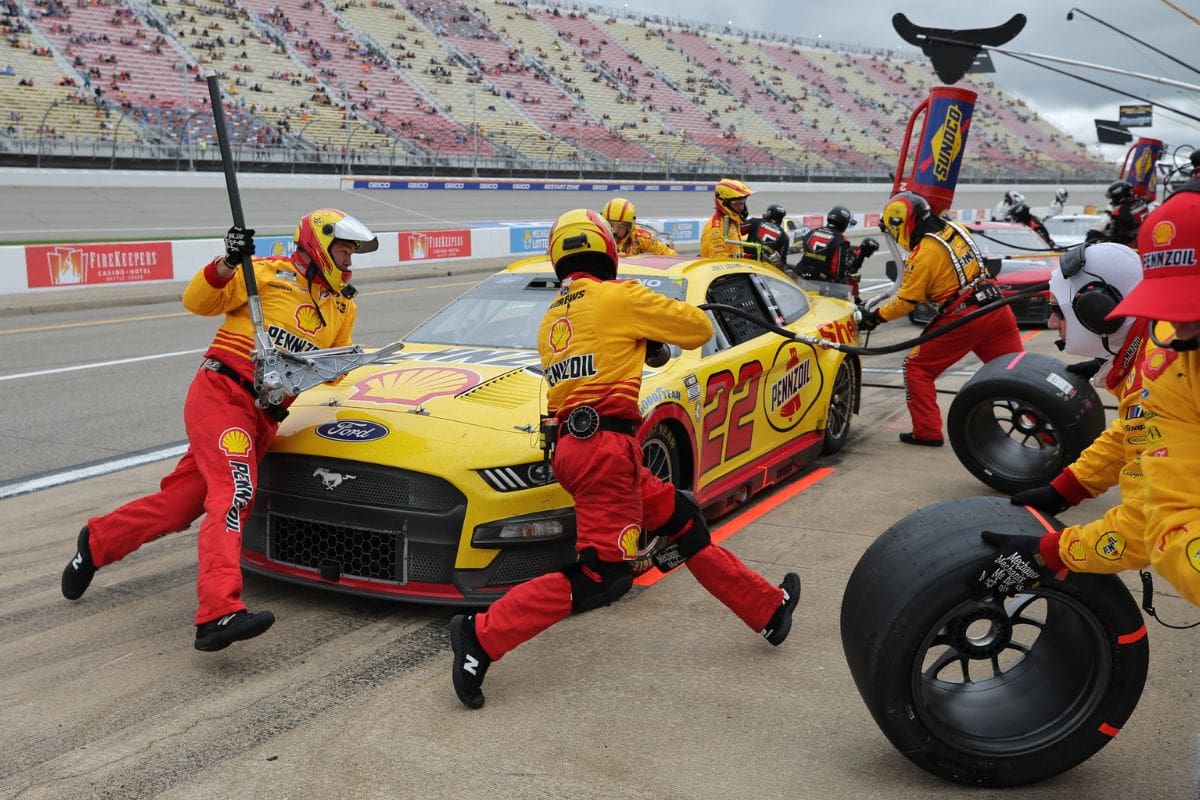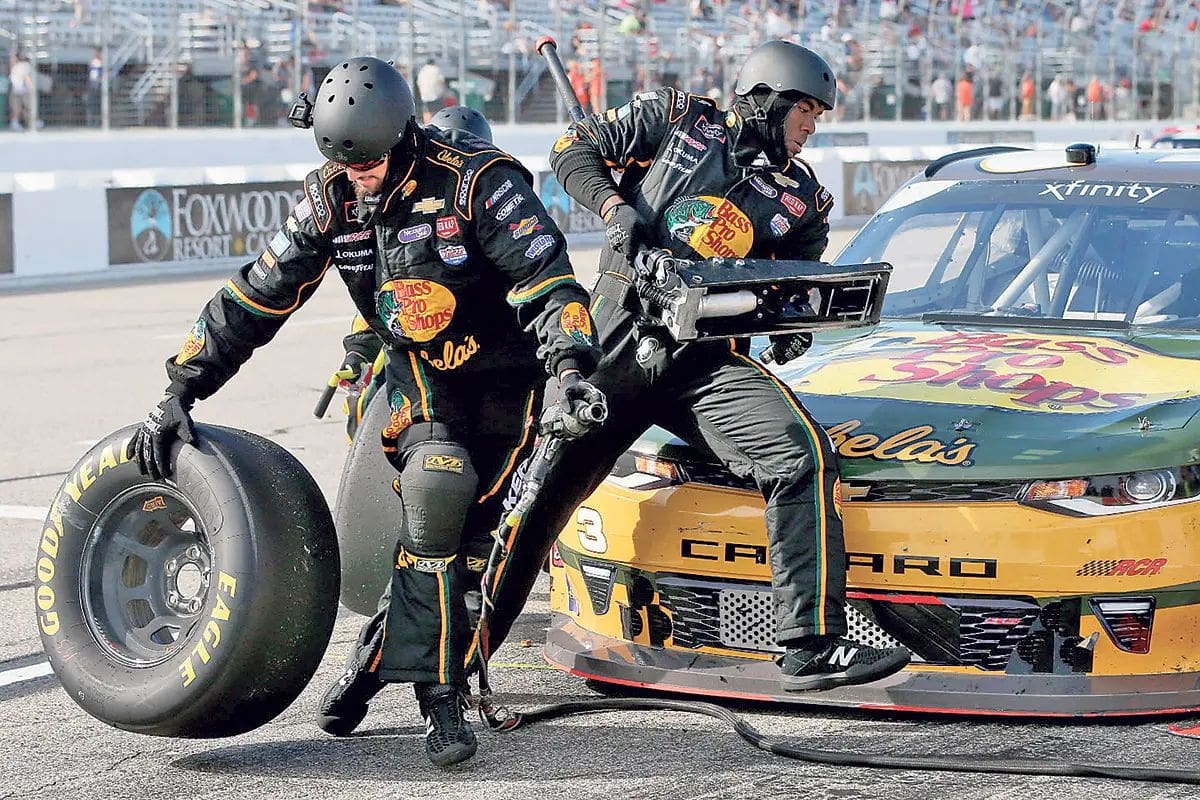Dale Jr.’s Take on NASCAR and Goodyear: Dale Earnhardt Jr.‘s insights into NASCAR’s recent tactical shift, marked by Goodyear’s introduction of dual tire compounds at Richmond Raceway, provide a compelling lens through which to examine the sport’s evolution. Earnhardt Jr. commends the inventive move, emphasizing its potential to enhance race quality and tactical depth. Yet, he remains cautious, advocating for testing and feedback loops to safeguard the integrity of competition. His balanced critique raises crucial questions about how these changes will impact the dynamics and excitement of future races, setting the stage for a deeper exploration of NASCAR’s adaptive strategies in tire technology.
Key Takeaways
- Dale Earnhardt Jr. views the dual tire compounds as adding tactical complexity and improving race quality.
- Earnhardt Jr. emphasizes the importance of maintaining competitive integrity with the introduction of new tire compounds.
- He stresses the need for thorough testing and feedback to fine-tune tire performance.
- Earnhardt Jr. believes the new tire strategy will reinvigorate racing dynamics at Richmond Raceway.
- The increased performance disparity between ‘hard’ and ‘soft’ tires is expected to enhance competitiveness and excitement.
Introduction to NASCAR’s Tire Strategy Shift
Introducing a dual-tire approach for the upcoming Richmond race, NASCAR’s decision to offer teams a choice between ‘prime’ and ‘option’ Goodyear tires marks a crucial shift aimed at enhancing tactical complexity and race excitement. Historically, NASCAR’s single-tire format has provided a level playing field, but it has also limited diverse strategies. The introduction of two distinct tire compounds promises to inject a new layer of depth, challenging teams to refine their race plans in creative ways.
The ‘prime’ tire is expected to offer durability and consistency, making it a reliable choice for long stints. Conversely, the ‘option’ tire, while potentially offering superior grip and speed, may come with trade-offs regarding longevity. This dichotomy forces teams to make calculated decisions about when to use each type of tire, considering factors such as track conditions, car performance, and race phase.
From an insider perspective, this move can be seen as NASCAR’s response to calls for more dynamic racing. By varying tire performance, the governing body is effectively handing teams the tools to create unique race plans that can shift the competitive landscape. The Richmond short track, known for its tight turns and high-intensity racing, is an ideal testing ground for this approach, where tire choice could significantly impact race outcomes.
Moreover, this change aligns with NASCAR’s broader goal of enhancing viewer engagement. Fans, particularly those who appreciate the intricacies of race plans, are likely to find the dual-tire format compelling.
Tire Specifications and Usage Rules
Given the dual-tire plan’s potential to reshape race dynamics, understanding the specific tire specifications and usage rules becomes essential for teams aiming to optimize their competitive edge at Richmond. The regulations stipulate that teams must utilize ‘prime’ tires for qualifying, with an allocation of six sets for the race. This base requirement ensures a level playing field while introducing a tactical element with the inclusion of ‘option’ tires.
The flexibility in tire selection is where strategic depth emerges. Teams are permitted to employ ‘option’ tires up to three times during the race weekend: one set during practice and two sets during the race. This latitude enables teams to tailor their approach based on real-time data and evolving race conditions. Here are three key considerations for teams:
- Performance Analysis: The ‘option’ tires are designed to offer a different performance profile compared to the ‘prime’ tires. Teams must meticulously analyze lap times, tire wear, and handling characteristics during practice sessions to make informed decisions.
- Strategic Deployment: Deciding when to use the ‘option’ tires during the race is vital. Optimal deployment can provide a notable advantage, especially during pivotal race phases such as restarts or green-flag runs.
- Resource Management: Allocating the six sets of ‘prime’ tires across the race demands careful management. Teams must balance immediate performance gains with the necessity of having fresher tires for significant late-race moments.
Background and Evolution of Tire Selection
The shift towards dual tire compounds in NASCAR represents a significant evolution in the sport’s tire selection approach, rooted in trial tests like the one conducted at the North Wilkesboro Speedway, All-Star Race. This non-points event allowed NASCAR to gather crucial data on tire performance and driver feedback, setting the stage for an innovative approach in tire strategy. Elton Sawyer, NASCAR’s senior vice president of competition, emphasized the experimental nature of this initiative, which has since evolved into a method for points-paying races.
“The All-Star Race is a great event obviously by itself, but it gives us the opportunity to learn. This past year, it gave us the chance to try something with tires, and we’re working really hard in NASCAR as well as the folks at the R&D Center to improve the short-track package. So the All-Star Race at North Wilkesboro gave us the opportunity to introduce the option tire, something we’d never done to my knowledge in the history of our sport, to have different compounds during an event.”-(elton)
The trial at North Wilkesboro illustrated the profound impact that tire compound selection could have on race dynamics. Drivers experienced firsthand the varying handling characteristics and performance levels, directly influencing race outcomes and strategies. This experiment provided fertile ground for NASCAR and Goodyear to refine their approach, ensuring that the implementation of dual compounds would add a layer of strategy and excitement to the races.
| Phase | Key Elements | Emotional Impact |
|---|---|---|
| Trial | Non-points race, driver feedback | Curiosity, anticipation |
| Data Collection | Performance analysis, adjustments | Insight, precision |
| Incorporation | Points-paying race integration | Excitement, strategic depth |
Dale Earnhardt Jr.’s Perspective and Critique
Dale Earnhardt Jr., reflecting on the lessons learned from the North Wilkesboro trial, offers a perspective on the forthcoming implementation of dual tire compounds at Richmond Raceway. Earnhardt Jr. expresses a blend of cautious optimism and critical analysis, underlining the potential benefits while also drawing attention to possible pitfalls.
“Yeah, all right, so we’ll see how it goes. Um, it was really a non-factor in the Wilkesboro race, and uh, we’ll see how it goes with Richmond. I’m not—I’m not going to get all that excited about it. Uh, it’s not what I was hoping. With the last race we had at Richmond, we came into this room and we went hard about what the, you know, we better get this figured out or we’re going to lose Richmond, or at least a Richmond race, right? So, I don’t want to forget—I don’t want to lose that energy of concern that we had because it was very serious.””-(dale jr.)
- Tactical Complexity: The introduction of dual tire compounds promises to add a layer of tactical depth, potentially creating unique scenarios where teams must judiciously manage tire selection and pit stop timing. This could lead to more dynamic racing and unexpected outcomes.
- Race Quality: Ensuring that the implementation of dual tire compounds does not detract from the overall race quality is paramount. Earnhardt Jr. stresses that the focus should remain on maintaining the integrity of the competition, with tire performance being consistent and reliable across different conditions.
- Competitive Integrity: While the dual tire strategy could democratize racing opportunities, it is vital to balance innovation with fairness. Earnhardt Jr. reminds us that any advantage gained through tire selection should improve, not overshadow, the skill and strategy inherent to NASCAR racing.
“While having 2 compounds did not make a big difference at Wilkesboro, Richmond is a different story. The track requires tire management, and drivers on the softer compound will need to be wary of that.”-(dale jr.)
Earnhardt Jr. remains apprehensive about the potential for tire-related issues that could disrupt the race flow, drawing parallels with past experiences at Wilkesboro. He underlines the need for thorough testing and feedback mechanisms to fine-tune the compounds before they become a staple in the racing circuit.
Dale Earnhardt Jr.’s perspective provides a valuable insider’s view that balances enthusiasm for innovation with a grounded understanding of the sport’s foundational principles. His insights serve as a reminder that while technological advancements are critical, they must be carefully managed to preserve the essence of competitive racing.
Expectations and Hopes for Improved Racing
Embracing a carefully optimistic stance, Earnhardt Jr. anticipates that the tactical adjustments to tire compounds will improve the competitive edge and reinvigorate the racing dynamics at Richmond Raceway. These modifications, specifically designed to boost the performance disparity between ‘hard’ and ‘soft’ tires, aim to restore the track’s historical competitiveness, a feature that has long been a hallmark of Richmond’s appeal to fans and drivers alike.
“Maybe they’ve made some adjustments and made a little bit broader gap between the hard tire and the soft tire to where there’s a bigger difference in time or speed and where, and so forth. We’ll just see how it goes. I’m hoping that there’s something that can improve the racing at Richmond and get it to where it’s the Richmond that we know and love.”-(dale jr.)
Earnhardt Jr. acknowledges that the interplay between tire wear and tactical pit stops could be crucial in elevating the racing spectacle. By creating a more pronounced difference in tire performance, Goodyear and NASCAR hope to introduce a new layer of strategy, compelling teams to make more critical decisions regarding tire management. This, in turn, could lead to more overtaking opportunities and varied race outcomes, thereby engaging the audience with a more dynamic and unpredictable racing environment.
From an insider perspective, Earnhardt Jr. understands the importance of these changes. He recognizes that tire compounds play a strategic role in the overall racing experience, influencing both the handling of the cars and the strategies employed by the teams.
The anticipation is that these adjustments will not only improve the competitive nature of the race but also bring back the excitement that fans have come to expect from Richmond.
News in Brief: Dale Jr.’S Take on NASCAR and Goodyear
The analysis of Dale Earnhardt Jr.’s perspective on NASCAR and Goodyear’s advanced dual tire compounds at Richmond Raceway reveals a delicate balance between embracing technological advancements and preserving the sport’s competitive integrity.
Earnhardt Jr.’s detailed critique highlights the importance of thorough testing and feedback to optimize race quality and tactical complexity.
This approach aims to improve racing dynamics while ensuring that the fundamental principles of NASCAR remain intact, promising an exciting evolution of the sport.
ALSO READ: Dale Earnhardt Jr’s NBC Comeback Rumors



